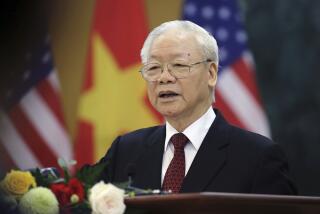National Agenda : Free Market Perils Vietnam’s Health : World agencies worry that the country may divert resources away from social needs, jeopardizing huge gains made in recent years.
- Share via
HANOI — Vietnam’s efforts to open up the country to foreign trade may well improve its flagging economy, but health experts fear that the pace of the free-market reforms is threatening gains made in recent decades in improving the health of the Vietnamese.
Already international health agencies like the United Nations Children’s Fund are reporting a drop in the use of health centers as services get worse and facilities deteriorate. Rural areas, where 85% of the country’s 71.5 million people live, are especially affected, according to UNICEF.
After many years of central government support, provinces and rural villages now must handle local problems alone as the government diverts funds away from health and social programs to projects aimed at building the gross national product. It’s all a part of Doi Moi , the free-market fiscal reforms first announced in 1986.
Doctors, nurses and community health workers in Vietnam’s extensive network of primary care centers now must charge fees in order to supplement their vanishing salaries, thus building a barrier to easy access by the poor. The average income in Vietnam is $250 a year; it drops to $85 in mountainous rural areas.
Many unregistered physicians, often without scruples, are taking advantage of entrepreneurship and joining the ranks of doctors who are quit the public system and go into private practice in places where there is money, due in part to foreign capital.
Vietnam made great strides improving literacy and creating a credible health system in the decades after independence from France in the 1950s. Eighty-five percent of the people are literate. A U.S. government report states that between 1945 and 1979, Vietnam built an extensive network of hospitals as well as 10,000 maternity clinics and rural health centers. The number of doctors grew from one physician for every 180,000 people in 1945 to one physician per 1,000 people by 1979. The average life expectancy grew from 34 years to 63 years during that period.
*
UNICEF statistics show that some major health indicators continued to improve into the 1990s. Life expectancy, for example, had grown to 67 years by 1990.Child death rates were reduced by half between 1980 and 1991, and immunization rates against measles and other childhood diseases rose sharply, due in part to World Health Organization and UNICEF programs.
But despite those improvements, 43% of children under age 5 are malnourished, and deaths from diarrhea and respiratory diseases, malaria and dengue fever are high among the young, according to UNICEF, which has health activities in 23 of the country’s 53 provinces. The organization also reports that only 21% of the rural population has access to safe drinking water and 17% to adequate sanitation; cholera is endemic in many places; 20% of newborns have low birth weight--a growing trend--and six out of 10 pregnant women have iron deficiency anemia. The concern among international agencies is that the government’s concentration on becoming an effective participant in the world community will result in damage to health and social infrastructures, which are key requirements for a prosperous future.
“ Doi Moi is indeed improving the general situation of Vietnam’s people but the reform pace is also placing in jeopardy social services for women and children--society’s most vulnerable,” UNICEF recently reported.
There is an urgent need, the agency says, for greater international assistance to help maintain the social and welfare gains of the past and to ensure that the economic reforms benefit all.
UNICEF is the only major organization currently helping the government to provide people with safe drinking water and improved sanitation. It also is engaged in improving nutrition, education and living arrangements for women. Poor sanitation and lack of safe water are the major factors jeopardizing the health of children in Vietnam.
On the outskirts of Hanoi, a Vietnamese factory that once made armaments is turning out water pumps for UNICEF partially paid for by village communes. They are used to draw clean ground water from wells dug by villagers, sometimes with outside help. Well drilling occurs simultaneously with health education programs and latrine projects so that the people will avoid using surface water for both drinking and elimination.
In the commune of Tu Ly, several hours by road northwest of Hanoi, an assistant doctor shows visitors through his primary care health center, which serves 5,000 rural residents. The three major health problems, he says, are malaria, malnutrition and goiters, the last due to lack of iodine in the diet. The center is sparsely equipped with the tools of medicine and drugs.
A midwife displays a rusty obstetrics table, a relic of the past, where 54 of the 55 babies born in the commune were delivered this year. The midwife, who has worked there for 10 years, is paid $6.25 a month.
In another commune, UNICEF is partially funding a pilot teacher training center that will supply instructors for first- through fifth-grade students in mountain villages as far as 60 miles away. The trainees, as well as the inhabitants of villages where they will teach, are members of ethnic minority tribes whose members are among the country’s poorest citizens.
The center is an example of how the agency works with the government to further improve the literacy rate. The 50 trainees range in age from 15 to 20 and are students themselves in the eighth and ninth grades.
*
Teachers, like doctors, have been quitting the profession because of low pay--$6 a month--and the schools are deteriorating, an official explains. Schooling is supposed to be free but is now subsidized only during the first four years, he says. Many youngsters stop at the fourth grade and go to work.
Dr. Duong Quynh Hoa, director of the Center of Pediatrics, Development and Health in Ho Chi Minh City, is one of the most outspoken critics of the government’s diversion of funds away from health and social programs. As minister of health in the north from 1966 to 1974, she played a role in developing the primary health care network that now is crumbling.
Hoa once was accused of being a dissident for insisting publicly that Vietnam had a serious malnutrition problem, a stand that few other critics could take safely at the time. She survived probably because of her longtime relationships with many of the nation’s leaders, which date to the 1950s.
Aside from seeing to adequate funding of the health system, Hoa’s efforts today include encouraging young health workers to become more politically active in opposing government policies that harm health. She also encourages the return of more Vietnamese exiles, whose goal is to help build their country.
A former Communist Party member, Hoa said in an interview that most Vietnamese still believe it is not possible to fight government policies. This is a mistake, she said, because “the government is very realistic and pragmatic” and there is a greater chance of quick change from old conformist ways of thinking than there is, for example, in China, which has a longer history of socialism.
But, she added, it is a mistake for the government “to say that we must commercialize health. There are two fields that cannot be commercialized--health and education. The lives of all the people must be improved. You can’t improve only at the top.”
More to Read
Sign up for Essential California
The most important California stories and recommendations in your inbox every morning.
You may occasionally receive promotional content from the Los Angeles Times.










